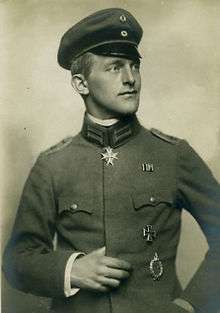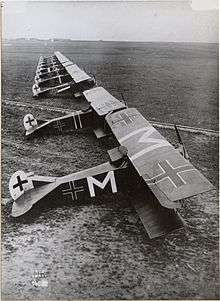Carl Menckhoff
Carl Menckhoff (14 April 1883 – 11 January 1949) was a German First World War fighter ace, credited with 39 confirmed victories. Already in his 30s when he learned to fly, he was one of the oldest pilots in the Imperial German Air Service. He transferred from infantry service to aviation as a non-commissioned officer, but afterwards succeeded in being commissioned as an officer. He won the Pour le Mérite ("Blue Max"), and was given a squadron command.
Carl Menckhoff | |
|---|---|
 | |
| Born | 14 April 1883 Herford, Westphalia, German Empire |
| Died | 11 January 1949 (aged 65) Switzerland |
| Allegiance | |
| Service/ | Imperial German Aviation Service |
| Years of service | 1914–1918 |
| Rank | Oberleutnant |
| Unit | Jagdstaffel 3 |
| Commands held | Jagdstaffel 72 |
| Awards | Pour le Mérite, Royal House Order of Hohenzollern, Iron Cross First and Second Class |
| Other work | Businessman in Germany and Switzerland |
Having been taken prisoner on 25 July 1918, he remained incarcerated until August 1919 when he escaped into Switzerland. He returned to Germany where he succeeded in business, but where he was arrested in 1938 for currency infringements. Following his release from custody he moved to Switzerland, where he remained until his death in 1949.
Early life
Carl Menckhoff was born in Herford, Westphalia, in the Kingdom of Prussia, the son of Friedrich Wilhelm Menckhoff (1853–1929) and his wife Luise née Siekmann (1856–1922).[1][2] He was one of a family of at least eight and possibly ten siblings.[2] His father ran a successful linen weaving mill, the Herforder Leinen-Verein Wilhelm Menckhoff, in which Carl was apprenticed and later (after a failed business enterprise of his own) employed.[3]
As a young man, Menckhoff was keenly interested in motor cars, and probably participated in balloon flights with his brother Willi (who held a balloon pilot's licence). He believed that this background helped his later application to join the Air Corps.[4]
Military service
Menckhoff reported for military service as a "one-year volunteer" at age 20 in 1903, but was invalided out after six weeks observation in a military hospital with suspected appendicitis.[5][6]
In August 1914, on the outbreak of war, Menckoff – now aged 31 – enlisted in Infantry Regiment Nr. 106.[1][7] He served on the Western Front, seeing action against the French in the vicinity of Châlons-en-Champagne and on the River Suippe, and later against the British in the vicinity of Armentières. He was wounded several times and received the Iron Cross First Class and Second Class for gallantry, both by the end of 1914.[8][9]
Aerial service
Left unfit for infantry service by his injuries, Menckhoff applied for transfer to the Luftstreitkräfte, and was accepted for pilot training in February 1915.[10] Having qualified, he was posted in October 1915 back to the Western Front, to an airfield at Pergnies-Quessey, near Saint-Quentin, where he was again wounded during an aerial engagement in January 1916.[11] In April 1916 he was transferred to the Eastern Front, where he was stationed at an airfield near Ashmyany. Here he gained useful flying experience but limited experience of combat.[12][13] It was in the east that he trained as a single-seat combat pilot at Warsaw.[14] At the end of 1916 he became a flight instructor in Cologne, and in January 1917 was promoted to Vizefeldwebel (staff sergeant).[15] He then returned to the Western Front, assigned as a fighter pilot to Jagdstaffel 3, at that time stationed at Fontaine-Uterte near Saint-Quentin, and equipped with the Albatros D.III.[16][17]
Menckhoff scored his first victory on 5 April 1917, downing a Nieuport 17 of No. 29 Squadron, Royal Flying Corps, flown by Lieutenant Norman Birks.[18][19] The victories began to mount rapidly after that,[20][21][22] though Menckhoff often returned from victorious flights shaken by his triumphs.[23][24] He was shot down several times, but always returned to duty.
On 23 September 1917, he is sometimes reported to have come to the aid of Werner Voss during the latter's battle against an overwhelming force from the Royal Flying Corps. Lieutenant Arthur Rhys-Davids (of No. 56 Squadron) allegedly turned from engaging Voss and damaged Menckhoff's Albatros so badly that he had to crash land it. Rhys-Davids then shot down Voss.[25] However, Menckhoff made no mention of this engagement in his later memoirs, and his involvement has been questioned.[26]

Menckhoff did fight planes of No. 56 Squadron on 28 September 2017.[27] In October he was promoted to Leutnant der Reserve.[28] In December he was awarded the Hohenzollern House Order, Knight's Cross 2nd Class with Swords.[29] By 4 February 1918 his victories totalled 20.[22][30] One week later, he was assigned command of Saxon Jagdstaffel 72 as its initial Staffelführer.[17][31][32] His leadership style conserved his men's lives and the squadron's subsequent 60 victories were claimed with the loss of only one of its own pilots.[33]
On 23 April 1918, his victory total having reached 25, he was awarded Germany's highest decoration for valor, the Pour le Mérite.[31][34]
Downfall and capture
On 25 July 1918, three days after his 39th victory, while flying one of his two Fokker D.VIIs, Menckhoff was shot down by Lieutenant Walter Avery of the 95th Aero Squadron, United States Air Service.[8][13][35][36][37] Captured by French troops at the crash site, Menckhoff was chagrined to learn that he was a rookie pilot's first victory. Avery cut the letter "M" from the crashed Fokker, but sportingly refused to deprive Menckhoff of his Pour le Merite.[8][38]
Following interrogation, Menckhoff was held as a prisoner of war, along with many other German pilots, at Camp Montoire, near Orléans.[13][39]
Post-war years
Menckhoff remained a prisoner long after the war ended in November 1918. Despairing of his release, he finally escaped on 23 August 1919. Travelling on foot, by rail, and at one point in a stolen car, he managed to reach Switzerland eight days later, crossing the border near Mont Salève and making his way to Geneva.[13][40] He subsequently returned to Germany and to Herford. In 1920 he moved to Berlin. Here he became manager of an airline, the Deutsche Luft Lloyd GmbH, but this failed in 1922–3.[41] In the late 1920s he founded a heating company, the Caliqua Wärmegesellschaft MBH: this was more successful, and he was able to establish daughter companies in France and Switzerland.[42]
He established a place of residence in Switzerland, but in October 1938, when crossing the German-Swiss border at Basel, he was found to be carrying an illegal quantity of Swiss francs. He was arrested by the German authorities and held in custody for more than eight months.[43] It was during this incarceration that he wrote a memoir of his First World War experiences.[44]
Having been forced to surrender many of his shares and business patents, he was released in May 1939. He was warned that further punishment might follow, and so in the autumn of 1939 he moved to Switzerland permanently. He settled in a villa in the grounds of Angenstein Castle, which was owned by his wife's family.[43] He remained there after World War II.
Carl Menckhoff died of complications following an operation on 11 January 1949.[45] He was buried in Basel.[46]
Personal life
Menckhoff married five times:
- In June 1905 to Elisabeth Alice Seyer. The marriage produced three daughters: Edelgarde, Elisabeth and Margot. It was subsequently dissolved.[47]
- In 1920 to Elisabeth ("Eli") Altmann. The couple divorced after three months.[48]
- In 1922 to Irmgard Dittrich. The marriage produced a daughter, Doris. The couple divorced in 1925.[49]
- In April 1926 to Anne-Marie Braun. The marriage produced a son, Carl Wilhelm. The couple separated in 1928; and the marriage was dissolved in 1936.[50]
- In 1936 to Leonore Quincke (1904–1980). The marriage produced a son, Karl Gerhard Georg Friedrich.[42]
Legacy
In May 2007, Walter Avery's daughter learned that Menckhoff's son, Gerhard Menckhoff, lived in the District of Columbia. She decided to return the fabric "M" from Menckhoff's crashed Fokker D.VII to the family. Gerhard Menckhoff explained he had not known his father was a war hero until after his death, and promised to pass the relic on to his son Carl, the German ace's namesake.[51][52]
Notes
- Guttman 2009, p. 22.
- Täger 2013, p. 12.
- Täger 2013, pp. 12, 14, 16.
- Täger 2013, pp. 14–16, 19–20, 72, 218–20.
- Täger 2013, pp. 15–16.
- Treadwell and Wood 2003, p. 128.
- Täger 2013, pp. 17.
- Franks et al. 2004, pp. 74–75.
- Täger 2013, pp. 17–18, 44–69, 225.
- Täger 2013, pp. 72–73.
- Täger 2013, pp. 21–22, 77–80.
- Täger 2013, pp. 82–96.
- Treadwell and Wood 2003, p. 129.
- Täger 2013, pp. 22, 96, 223.
- Täger 2013, pp. 96–98, 223.
- Täger 2013, pp. 100–101, 223.
- "Who's Who – Carl Menckhoff". firstworldwar.com. Retrieved 19 October 2014.
- Täger 2013, pp. 103–104, 179–80.
- Franks, Guest and Bailey 1995, p. 19.
- Täger 2013, pp. 182–88, 238–44.
- "Karl Menckhoff". The Aerodrome. Retrieved 20 June 2014.
- Franks, Bailey and Guest 1993, p. 164.
- Kennett 1999, p. 169.
- Täger 2013, pp. 25–26.
- Guttman and Dempsey 2008, pp. 21–22.
- Täger 2013, pp. 186–87, 252.
- Täger 2013, pp. 187–88.
- Täger 2013, pp. 23, 223, 225.
- Täger 2013, p. 225.
- Täger 2013, p. 239.
- Franks et al. 2004, p. 74.
- Täger 2013, pp. 120–21, 188–93, 223.
- Handleman 2003, p. 43.
- Täger 2013, pp. 23, 239.
- Wales, Henry G. (July 27, 1918). "German "Ace" is shot down". The Pharos-Reporter. Logansport, Indiana.: published online in "The Aerodrome Forum". The Aerodrome. 20 October 2007. Retrieved 20 June 2014.
- Täger 2013, pp. 146–48, 193–203, 264–66.
- Guttman 2009, p. 14.
- Täger 2013, pp. 204–6.
- Täger 2013, pp. 148–64.
- Täger 2013, pp. 164–77.
- Täger 2013, pp. 28–35.
- Täger 2013, p. 36.
- Täger 2013, pp. 36–39.
- Published in Täger 2013, pp. 44–178.
- Täger 2013, pp. 40–42.
- Täger 2013, pp. 42–43.
- Täger 2013, p. 15.
- Täger 2013, pp. 28, 30.
- Täger 2013, p. 35.
- Täger 2013, pp. 35–6.
- "Dogfight trophy of 1918 returned". Washington Times. 11 May 2007. Retrieved 19 June 2014.
- Täger 2013, pp. 208–10.
Sources
- Memoir
- Täger, Hannes, ed. (2013). Carl Menckhoff: Reminiscenses of War and Captivity: a Knight of the Pour le Mérite reports. Indio, CA: Aeronaut Books. ISBN 978-1935881179.
- Secondary published sources
- Franks, Norman; Bailey, Frank W.; Guest, Russell (1993). Above the Lines: The Aces and Fighter Units of the German Air Service, Naval Air Service and Flanders Marine Corps, 1914–1918. London: Grub Street. ISBN 0-948817-73-9.
- Franks, Norman L. R.; Guest, Russell; Bailey, Frank W. (1995). Bloody April ... Black September. London: Grub Street. ISBN 1-898697-08-6.
- Franks, Norman; et al. (2004). Fokker D VII Aces of World War 1: Part 2. Osprey. ISBN 1-84176-729-8.
- Handleman, Philip (2003). Combat in the Sky: the Art of Aerial Warfare. Zenith Imprint. ISBN 0-7603-1468-3.
- Kennett, Lee (1999). The First Air War: 1914–1918. Simon and Schuster. ISBN 0684871203.
- Guttman, Jon; Dempsey, Harry (2008). Sopwith Camel Vs Fokker Dr I: Western Front 1917–18. Osprey. ISBN 1846032938.
- Guttman, Jon (2009). SE 5a Vs Albatros D V: Western Front 1917–18. Osprey. ISBN 184603471X.
- Guttman, Jon (2009). Spad XIII Vs. Fokker D VII: Western Front 1916–18: Part 7. Osprey. ISBN 1846034329.
- Shores, Christopher (2001). British and Empire Aces of World War I. Osprey Publishing. ISBN 1-84176-377-2.
- Treadwell, Terry C.; Wood, Alan C. (2003). German Fighter Aces of World War One. Stroud: Tempus. ISBN 075242808X.
- Online
- "Who's Who – Carl Menckhoff". firstworldwar.com. Retrieved 19 October 2014.
- "Karl Menckhoff". The Aerodrome. Retrieved 19 October 2014.
- "The Aerodrome Forum". The Aerodrome. 20 October 2007. Retrieved 19 October 2014.
- "Dogfight trophy of 1918 returned". Washington Times. 11 May 2007. Retrieved 19 October 2014.